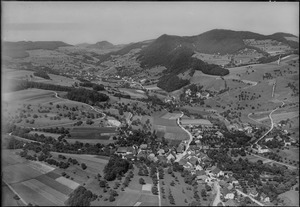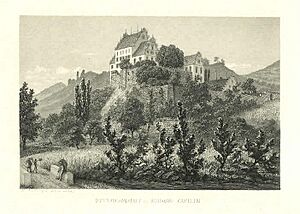Oberflachs facts for kids
Quick facts for kids
Oberflachs
|
||
|---|---|---|
 |
||
|
||
| Country | Switzerland | |
| Canton | Aargau | |
| District | Brugg (district) | |
| Area | ||
| • Total | 3.38 km2 (1.31 sq mi) | |
| Elevation | 401 m (1,316 ft) | |
| Population
(Dec 2011)
|
||
| • Total | 498 | |
| • Density | 147.3/km2 (381.6/sq mi) | |
| Postal code |
5108
|
|
| Surrounded by | Auenstein, Schinznach-Dorf, Thalheim, Veltheim | |
| Twin towns | Seitingen-Oberflacht (Germany) | |
Oberflachs was once a small town, also called a municipality, in Switzerland. It was part of the Brugg area in the Canton Aargau. You can find it about 6 kilometers (about 3.7 miles) southwest of the town of Brugg.
On January 1, 2014, Oberflachs joined with another town called Schinznach-Dorf. Together, they formed a new, bigger town named Schinznach.
Contents
History of Oberflachs
People have found old Roman bricks and coins in Oberflachs. This shows that people lived here a very long time ago. The first time Oberflachs was written about was in 1342. It was called Obreflaht back then.
For many years, from the Middle Ages until 1732, Kasteln Castle had special rights over the village. This included the power to make decisions about smaller legal matters. The city of Bern gained control over more serious legal matters in 1460. In 1732, Bern bought Kasteln Castle. This meant the village came completely under Bern's control. By 1607, Oberflachs was already acting like a partly independent town.
In the 1700s, Oberflachs was a very poor area. People mostly grew grain and grapes for wine. But in 1850, the wine business faced big problems. Diseases ruined the grapevines. This made many people, especially in the 1880s, leave Oberflachs to find work in other countries. Luckily, the wine industry got better. By 1990, about 22 hectares (about 54 acres) of land were used for growing grapes again.
In the 1970s, new homes were built in Oberflachs. More people started traveling to other towns for work than those who worked in Oberflachs itself. In 2005, farming still provided jobs for 28% of the people. In 2009, there was a plan for Oberflachs to join with four other towns. But the people in Veltheim voted against it, so the plan didn't happen.
Geography of Oberflachs
Before it merged, Oberflachs covered an area of about 3.4 square kilometers (1.3 square miles). A large part of this land, about 54.4%, was used for farming. Forests covered about 37.6% of the area. The remaining 8.9% was used for buildings and roads.
Most of the built-up area was for homes and other buildings (5.9%). Roads and other transport areas made up 2.4%. The forests were very dense, covering 34.6% of the land. Small groups of trees or orchards covered another 3.0%. For farming, 18.0% of the land grew crops. Pastures for animals made up 25.7%. Another 10.7% was used for orchards or vineyards.
Oberflachs is located in the Brugg area, at the bottom of the Schenkenbergertal valley. The town itself is a linear village, meaning it stretches out along a road. Kasteln Castle is also part of the area. The highest point in Oberflachs is about 770 meters (2,526 feet) high. The lowest point is about 395 meters (1,296 feet) high.
Coat of Arms
The blazon (a special description) of Oberflachs's coat of arms is: "Silver background with three blue flax flowers. They have gold seeds and green stems and leaves. They are arranged in a cross shape."
This design is an example of "canting arms". This means the picture on the coat of arms hints at the town's name. In German, the word for flax is Flachs.
People of Oberflachs
In 2011, Oberflachs had a population of 498 people. About 4.2% of the people living there in June 2009 were from other countries. Over ten years (1997–2007), the number of people living in Oberflachs grew by 10.7%.
Most people in Oberflachs (98.3%) speak German. English is the second most common language (1.1%), and Italian is third (0.4%).
In 2008, the ages of people in Oberflachs were:
- 56 children (11.7%) were 0 to 9 years old.
- 70 teenagers (14.6%) were 10 to 19 years old.
- 39 adults (8.1%) were 20 to 29 years old.
- 62 adults (12.9%) were 30 to 39 years old.
- 78 adults (16.3%) were 40 to 49 years old.
- 63 adults (13.1%) were 50 to 59 years old.
- 59 older adults (12.3%) were 60 to 69 years old.
- 35 older adults (7.3%) were 70 to 79 years old.
- 13 people (2.7%) were 80 to 89 years old.
- 5 people (1.0%) were 90 years or older.
In 2008, there were 211 homes and apartments in Oberflachs. About 113 of these (53.6%) were single-family houses. No apartments were empty. In 2007, about 4.1 new homes were built for every 1000 people.
In the 2007 Swiss national election, the most popular political party was the SVP. They received 45.1% of the votes. The next most popular parties were the FDP (12.1%), the Green Party (11.5%), and the SP (9.9%).
About 80% of the people in Oberflachs (aged 25–64) have finished high school or gone on to higher education. This includes university or a special college called a Fachhochschule. In the 2008/2009 school year, 48 students attended primary school in Oberflachs.
Here's how the population of Oberflachs has changed over time:
| Historical population | ||
|---|---|---|
| Year | Pop. | ±% |
| 1764 | 215 | — |
| 1850 | 512 | +138.1% |
| 1900 | 428 | −16.4% |
| 1950 | 364 | −15.0% |
| 2000 | 468 | +28.6% |
Sights to See
The village of Oberflachs is recognized as an important Swiss Heritage Site. This means it has special historical or cultural value.
Economy and Jobs
In 2007, the unemployment rate in Oberflachs was low, at 1.3%. In 2005, 37 people worked in the primary economic sector. This means they worked in farming or other natural resource jobs. There were about 12 businesses in this area.
Another 22 people worked in the secondary sector. This includes jobs like manufacturing or construction. There were 4 businesses in this sector. The largest group, 74 people, worked in the tertiary sector. These are jobs in services, like shops or offices. There were 10 businesses in this sector.
In 2000, 226 people who lived in Oberflachs had jobs. Most of them (about 77.4%) traveled outside Oberflachs for work. However, 49 people came into Oberflachs to work. There were 100 jobs available in the town that were at least 6 hours per week. About 5.1% of working people used public transport to get to work. A much larger group, 55.1%, used a private car.
Religion
Based on a survey in 2000:
- 76 people (16.2%) were Roman Catholic.
- 340 people (72.6%) belonged to the Swiss Reformed Church.
- 1 person belonged to the Christian Catholic faith.
See also
 In Spanish: Oberflachs para niños
In Spanish: Oberflachs para niños






